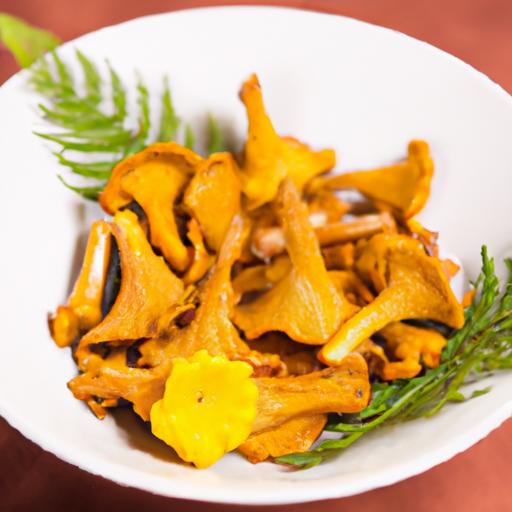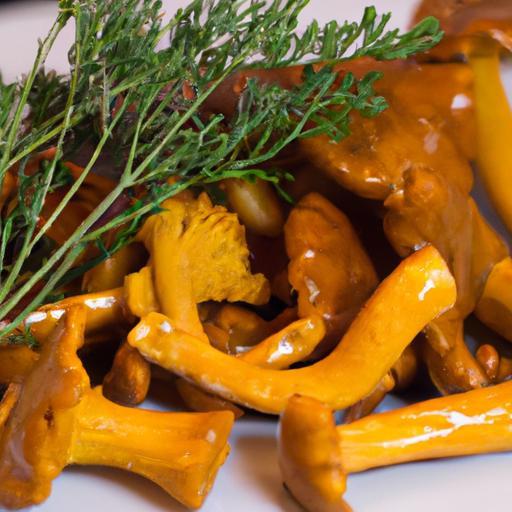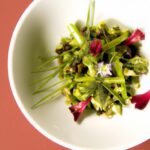Hidden in the dappled shadows of ancient forests, chanterelle mushrooms gleam like nature’s own golden treasure. Revered by foragers and chefs alike, these delicate fungi boast a rich, earthy flavor with subtle hints of apricot and honey. But their fleeting season leaves many longing for a taste long after the autumn leaves have fallen. Enter pickling-a time-honored preservation method that transforms fresh chanterelles into tangy, vibrant gems, ready to elevate any dish throughout the year. In this flavorful guide, we’ll delve into the art and science of pickling chanterelles, unlocking the secrets to capturing and savoring the very essence of nature’s gold.
The Art of Harvesting Chanterelles for Optimal Flavor
Pickled chanterelles begin their journey in the wild, where finding these golden treasures is both a mindful and rewarding experience. Harvesting chanterelles at their peak-firm, vibrant, and free of blemishes-ensures the preserved result bursts with that signature earthy, nutty flavor. Seek out chanterelles growing on mossy forest floors, ideally after a light rain, when their aroma is most pronounced. Use a small knife to cut the mushrooms at the base to protect the mycelium and allow for future growth. Gently brush off any dirt or debris without washing them, as excess moisture can dilute their flavor during pickling.
Crafting the Perfect Brine Balance for Pickling Chanterelles
Creating the ideal brine is the heart of preserving these chanterelles, striking a harmonious balance between tartness, saltiness, and subtle sweetness that complements their natural taste. Begin with a well-measured mix of white vinegar, water, and kosher salt, adding aromatic elements like garlic cloves, peppercorns, fresh dill, and a touch of sugar to deepen complexity. Simmer this blend until the sugar and salt fully dissolve, creating a clear, flavorful base that both tenderizes and preserves the chanterelles’ texture and vibrance.
Step-by-Step Techniques to Achieve Crisp and Tangy Preserves
- Clean and prepare the chanterelles. Gently brush and trim them, leaving larger mushrooms halved or quartered so they pack well in jars.
- Blanch the chanterelles. Immerse in boiling water for 1-2 minutes, then plunge into ice water immediately to halt cooking-this locks in crispness.
- Drain thoroughly. Let them dry on a clean towel to prevent an overly watery brine.
- Prepare the pickling brine. In a saucepan, combine vinegar, water, kosher salt, sugar, peppercorns, dill, and garlic. Bring to a gentle boil over medium heat.
- Fill sterilized jars. Pack chanterelles firmly but gently to avoid bruising.
- Pour the hot brine. Cover the mushrooms entirely, leaving some headspace at the top.
- Seal and process. Close with sterilized lids and process in a boiling-water bath for 10 minutes to ensure safety and longevity.
- Cool and store. Let jars cool to room temperature, then refrigerate or store in a cool, dark place for at least two weeks-then enjoy!
Storage Tips and Creative Culinary Uses for Pickled Chanterelles
Stored properly, pickled chanterelles can last up to 6 months in a cool environment, gaining more complex flavors over time. Refrigerate after opening and consume within 3 weeks for best taste and texture. These vibrant preserves are versatile: add a spoonful atop warm goat cheese crostinis for an elegant appetizer, fold into creamy potato salads for a tart contrast, or serve alongside smoked meats and charcuterie. For an unexpected twist, stir them into risottos, pasta dishes, or grain bowls, where their crisp tang beautifully enhances earthy and rich elements.
Prep and Cook Time
- Prep Time: 30 minutes
- Cook Time: 15 minutes
- Pickling Rest Time: 14 days minimum
Yield
- Makes approximately 4 (8 oz) jars of pickled chanterelles
Difficulty Level
- Medium
Ingredients
- 1 lb fresh chanterelle mushrooms, cleaned and trimmed
- 2 cups white vinegar (5% acidity)
- 2 cups water
- 1 tbsp kosher salt
- 1 tbsp granulated sugar
- 4 garlic cloves, peeled and lightly crushed
- 1 tsp black peppercorns
- 2 sprigs fresh dill
- Optional: 1 small bay leaf per jar
Instructions
- Prepare the chanterelles. Carefully brush off dirt and trim stems, halving larger mushrooms.
- Blanch mushrooms. Drop chanterelles into boiling water for 1-2 minutes. Transfer immediately to ice water to cool.
- Drain well. Pat dry with paper towels to remove excess moisture.
- Make pickling brine. In a saucepan, combine vinegar, water, salt, sugar, garlic, peppercorns, and dill. Heat until salt and sugar dissolve, then remove from heat.
- Pack sterilized jars. Add a bay leaf to each jar if desired, then fill jars tightly with mushrooms.
- Pour hot brine. Cover mushrooms completely, leaving ½ inch headspace.
- Seal and process jars. Screw lids on firmly and process in a boiling-water bath for 10 minutes.
- Cool and rest. Allow jars to cool at room temperature, then refrigerate or store in a cool, dark spot. Wait 14 days for full flavor development.
Chef’s Notes: Tips for Success
- Be sure to use vinegars with 5% acidity to ensure safe preservation.
- Don’t wash mushrooms under running water; use a brush to maintain their flavor intensity.
- Adjust sugar and salt amounts to suit your taste; more sugar softens acidity, more salt increases preservation strength.
- Try adding other aromatics such as mustard seeds or cloves for varied profiles.
- For quicker use, allow pickled chanterelles to sit in the brine in the fridge for 3 days before eating, though flavor improves over time.
Serving Suggestions
Presenting your pickled chanterelles can be as creative as the preserving process itself. Garnish crostinis with a sprig of fresh dill and a drizzle of honey to create a sophisticated appetizer. Use them as a tangy topping on grilled sausages or roasted vegetables. Fold into creamy dips or alongside rich pâtés to provide a crisp counterpoint. Their zesty bite is also delightful tossed in fresh, peppery arugula salads or even layered on gourmet sandwiches.
| Nutrient | Per 1/4 cup (30g) |
|---|---|
| Calories | 20 kcal |
| Protein | 1.2 g |
| Carbohydrates | 3.0 g |
| Fat | 0.1 g |
For expanding your culinary adventures with mushrooms, explore our related guide on Wild Mushroom Recipes. To deepen your understanding of wild fungi safety, check the authoritative guide from the U.S. Forest Service.

Q&A
Q&A: Pickled Chanterelles – A Flavorful Guide to Preserving Nature’s Gold
Q1: What makes chanterelles the “gold” of the forest?
A1: Chanterelles are often called nature’s gold because of their vibrant golden hue and prized, delicate flavor. These wild mushrooms are a seasonal treasure for foragers, celebrated for their fruity aroma and slightly peppery bite that adds magic to any dish.
Q2: Why pickle chanterelles instead of freezing or drying them?
A2: While freezing and drying are common preservation methods, pickling chanterelles unlocks a whole new realm of taste. The tangy brine enhances their natural earthiness, creating a complex flavor profile that’s both bright and savory. Plus, pickled chanterelles can be enjoyed straight from the jar, making them a convenient and delicious pantry staple.
Q3: What is the basic process of pickling chanterelles?
A3: The process involves gently cleaning the mushrooms, blanching them briefly to preserve texture, and then immersing them in a hot vinegar-based pickling solution infused with herbs, spices, and sometimes a touch of sweetness. After sealing in sterilized jars, the mushrooms soak in the brine, marrying flavors over time.
Q4: Which herbs and spices work best in pickled chanterelles?
A4: Traditional pickling spices like mustard seeds, peppercorns, bay leaves, and dill pair beautifully with chanterelles. Adding a hint of garlic or a sprig of thyme can elevate the mushrooms’ subtle fruity notes, resulting in a perfectly balanced jar of forest flavor.
Q5: How long do pickled chanterelles keep, and how should they be stored?
A5: Properly sealed pickled chanterelles can last for several months stored in a cool, dark place. Once opened, refrigerate and enjoy within a few weeks for the best taste and texture. The longer they mellow, the more harmonious and nuanced their flavor becomes.
Q6: What are some creative ways to enjoy pickled chanterelles?
A6: These golden gems add brightness to cheese boards, enliven salads, and complement roasted meats effortlessly. Try tossing them with fresh pasta or layering them on toasted sourdough with creamy goat cheese for a gourmet snack. Their versatility is as rich as their flavor.
Q7: Any tips for foragers wanting to pickle their own chanterelles?
A7: Harvest chanterelles early in the season when they’re firm and bright. Always clean them gently – avoid soaking, which can waterlog the delicate mushrooms. And remember: pickling is both an art and a science, so experiment with flavors until you find your perfect brine.
With their golden glow and distinctive taste, pickled chanterelles are a wonderful way to preserve a piece of the forest’s fleeting bounty-ready to savor all year round.
In Summary
As the final brine settles and the vibrant hues of your pickled chanterelles deepen, you’ve not only preserved a seasonal treasure but also captured a burst of forest magic ready to elevate any dish. Whether tucked into a sandwich, stirred into a creamy risotto, or enjoyed straight from the jar, these golden gems carry with them the essence of nature’s fleeting bounty. Embracing the art of pickling chanterelles is more than preservation-it’s a celebration of flavor, tradition, and the joy of savoring nature’s gifts well beyond their season. So, gather your foraging basket and jar of brine, and let the alchemy of pickling transform your chanterelle harvest into culinary gold that shines all year long.


